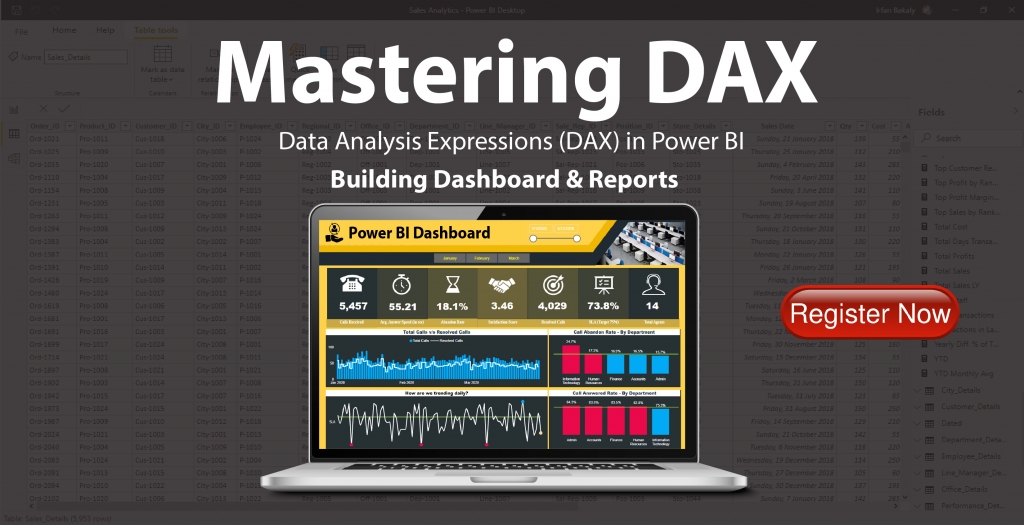Mastering DAX in Power BI is essential for any data analyst or business intelligence professional. DAX, or Data Analysis Expressions, is a powerful language used for creating calculated columns and measures in Power BI. It allows users to perform complex calculations, filter data, and analyze large datasets in a highly efficient manner. Some key skills to master in DAX include understanding how to use functions, variables, and operators, as well as being able to write complex formulas and queries. Additionally, it is important to have a strong understanding of Power BI’s data model and the relationship between tables and columns. With practice and dedication, mastering DAX in Power BI can greatly enhance your ability to analyze and interpret data in a meaningful way.
Mastering DAX
Course Duration & Payment Details
Days: Monday & Wednesday
Timing: 07:00 to 09:30pm
Duration: 20 hours
Starting from: Monday, 04 January 2021
Last date of registration: Friday, 25 December 2020
Actual Fee: 18000/- | Early bird discount: 9000/-
How to Pay: Online Payment
Bank: Habib Bank Limited (26 street, Badar Commercial, DHA Karachi)
Title: Irfan
Account No: 0011557900292501 | PK02HABB0011557900292501
Mastering DAX Outline
-
Introduction to DAX
- What is DAX?
- Data type and operators
- Syntax of DAX
- Understanding calculated columns and measures
- Why is a measure more efficient than a column?
- Creating calculated columns
- Formatting DAX code
- Implicit and explicit measures
- Understanding filter context
- Understanding Aggregations filter context
- Iteration / Row context
- Measure referencing
- Editing / Deleting measures
- Logical Operations
- Using variables to simplify formulas
- Writing comments in formulas
- What are Quick Measures?
- Quick measure feature
-
Relationship
- Working with Multiple tables
- Defining Relationship
- Editing and handling multiple relationships
-
Measures
- Implicit and explicit measures
- Measure referencing
- Editing / deleting measures
-
Date & Time Functions
- CALENDAR
- CALENDARAUTO
- DATE
- DATEDIFF
- DATEVALUE
- DAY
- EDATE
- EOMONTH
- HOUR
- MINUTE
- SECOND
- TIME
- TIMEVALUE
- MONTH
- YEAR
- FORMAT
- NOW
- TODAY
- WEEKDAY
- WEEKNUM
-
Filter Functions
- ALL
- ALLEXCEPT
- ALLSELECTED
- CALCULATE
- CROSSFILTER
- EARLIER
- FILTER
- HASONEVALUE
- ISFILTERED
- RELATED
- USERELATIONSHIP
- VALUES
-
Math & Trig Functions
- ABS
- CEILING
- DIVIDE
- ROUND
- ROUNDUP
- SUM
- SUMX
-
Logical Functions
- IF
- IFERROR
- AND
- OR
- SWITCH
-
Time Intelligence Expressions
- DATESMTD
- DATESQTD
- DATESYTD
- DATEADD
- DATESBETWEEN
- PERVIOUSDAY
- PERVIOUSMONTH
- PERVIOUSQUARTER
- PERVIOUSYEAR
- RUNNING TOTAL
- SAMEPERIODLASTYEAR
-
Statistical Function
- AVERAGE
- AVERAGEX
- COUNT
- COUNTA
- COUNTBLANK
- COUNTROWS
- COUNTX
- CROSSJOIN
- DISTINCTCOUNT
- MAX
- MAXX
- MIN
- MINX
- MEDIANX
- RANKX
- SUMARIZE
- TOPN
-
Text Functions
- CONCATENATE
- FORMAT
- LEFT
- LEN
- LOWER
- REPT
- RIGHT
- TRIM
- UNICHAR
- UPPER
- VALUE
- Top N Values, Top N Filter, Top Order calculations, Top 10 Customers, Dynamic
- Date Table, More Scenarios of Using Calculated Tables, Performance Consideration


